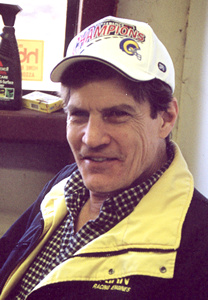|
|
|
|||
|
|
||||
|
Don: The upper end features home ported 2V heads with 2.19/1.71 stainless valves. Intake port work involved opening the pockets for a smooth transition for the larger valve seats, cleaning and shaping the intake runners without trying to over size, working the floor transition to the valve and port matching to the intake. Exhaust work involved opening the exhaust ports to match the gaskets with all work concentrated in the bowl, short turn and the roof area. The chambers are open and average 74cc for a 9.3 CR. The cam is a hydraulic grind, 214/224 (@.050) 107/117 lobe center, .510/.536 lift set at 1 degree advanced. The springs are Crane with 10 degree locks, 100 lbs seat, 280 open. Stock length pushrods and Crane roller rockers complete the valvetrain. The intake is a Weiand X-celerator with a Holley 750 (list 3310 modified with rear metering block and small downleg boosters). I have the optional plenum divider installed and a 4-hole plastic spacer on top of that. A 4"x14" K&N sits on top and draws air from a scoop open at the base of the windshield. The exhaust is 1 3/4", 34" tube headers (HPC coated) with 3' 2 1/2" pipes terminating in Thrush Turbo mufflers. Ignition is an Accel rebuild Ford DuraSpark distributor with a Mallory IIIA box. Timing is 17 initial, 40 total, all in by 2800, mechanical advance only. Oil pressure is 40 lbs at idle fully warmed with 10W-30 Valvoline. I feel that this combo is fairly well matched but feel free to comment. The problem - the motor goes flat right at 6000. I mean flat, done, ain't no more. It feels all the world like valve float. It does not appear to be fuel because when I shift, the motor takes right off. If it was ignition related, I assume that it would break up, but there is no miss. It just runs out of oomph. I suspect the hydraulic lifters, but Crane assures me that they should be good to 6500. To get the best performance, I would like to shift at 6200. Is the high oil pressure affecting the lifter's performance? Is the cam timing too short for that engine speed? Any clues would be greatly appreciated. Thanks very much for your time. Chris Kelly Chris, First of all, you need more camshaft! Instead of a 214/224 @ .050 I suggest something in the 231/239 @ .050 range. Isky Racing Cams' line of "Mega" cams is one option. We have built many of these engines and they have a power range of 3000-7000 rpm with a spring pressure of 130-lbs on the seat and 350-lbs open with anti-pump up lifters. Your choice of intake and spacer was good. The four-hole spacer helps your torque curve on cylinder heads that basically flow too well. Also, you might back the total timing down to between 36-38 degrees. Naturally, a cam like this requires a converter with a stall speed in the 3000-3500 range if your are using an automatic trans. Hope these tips will help. |
||||
|
Copyright 1999-2001, Drag Racing Online and Racing Net Source |
||||

